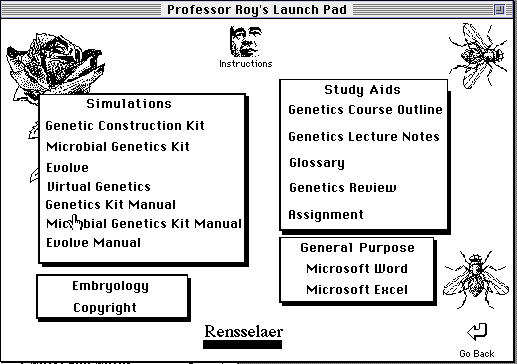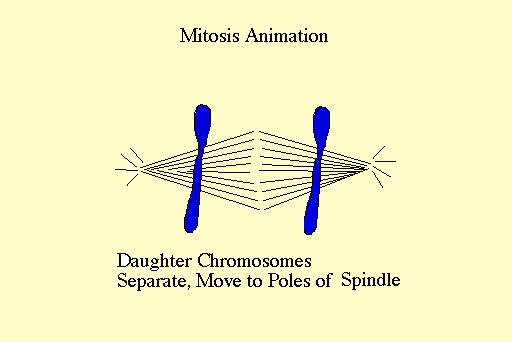
Figure 1. Professor Roy's Launch Pad Interface
Abstract
I am using the studio method to teach "Genetics and Evolution" at Rensselaer Polytechnic Institute (RPI). This method de-emphasizes lecturing in favor of laboratory simulations (using Visual Genetics and BioQuest programs), working problems, and carrying out longer term projects (with BioQuest programs). In the studio method, what works best is a short presentation using a projector with on-line notes or animations, followed by interactive work by teams of students using laboratory simulations or an assigned problem. Once this is done, another topic may be presented by the instructor, and the process repeated with new material.
The genetics course in the RPI Biology Department uses the Biosimulation
Laboratory, a suite of Macintosh computers arranged peripherally
in a single room. Since the summer of 1994, I have run the class
using the studio model, which employs brief concept presentation,
computer simulation, and problem solving exercises. There are
no separate lectures or laboratories in this course. I employ
interactive learning methods, ensuring that students have the
opportunity to work with one another, as well as on their own.
I provide on line notes, on line problems and solutions, and a
textbook. The students therefore have an extensive array of resources,
both written and on line, that permit them to approach the material
in a variety of ways.
Software Resources
The laboratory software for the course runs from Professor Roy's
Launch Pad, a simple Hypercard 2.2 stack which has buttons that
launch the other applications most often used by the students
(Figure 1).


| View Animation of Mitosis | View Animation of Bacterial Conjugation |
For example, the Genetics Construction Kit presents the student with a list of several different categories of experiment. The variety and complexity of these experiments cover a wide range. When the student selects one of these, the program uses the laws of genetics and some instructor-set guidelines to generate a simulated population of organisms that have hidden genetic properties, but visible variations. No two problems generated in this way are identical. It is then up to the student (or pair of students) to use the capabilities of the program to deduce the genetic properties of the organisms. These capabilities include the ability to simulate mating between two individuals, and to generate a new population of organisms based on this simulation. A random number generator within the program keeps the data from being "too perfect." In effect, the student can carry out a genetics experiment in an hour that would take months in a real laboratory. The student may copy the data to other programs, to analyze it or to write a report. Students may make oral presentations of their data and enter into discussions in class. The purpose of this exercise is to give the students a feeling for the random variation of genetic data, and the uncertainty that surrounds the design of experiments.
Another useful resource is a Macintosh version of Visual Genetics
that I am developing in conjunction with Alan Day at the University
of Western Ontario. This contains problem sets, simulations of
many genetic experiments with emphasis on fungal genetics, and
animations that describe numerous topics. Students find these
useful for getting a more complete feel for genetic experiments,
especially if they are not currently taking a laboratory course
in genetics.
Typical Class
Usually I give a brief presentation, using a very bright projector to avoid having to darken the room too much. My podium is in the middle of the room, so the students can turn in their chairs to see me, or they can monitor on line notes by looking either at the projection screen, or at their own computer. They are in control of the display on their computers, so they can lag behind or jump ahead if they choose. I try to keep the presentation down to 15 or 20 minutes. Then I turn the students' attention to a problem or simulation program. While they work on this, I and my teaching assistant wander about, checking on the students' progress. When most of them have "got it," I re-engage their attention, and we go on to another topic. A good deal of information passes laterally from student to student this way, and yet every student has a good opportunity to talk to the professor in class, with very little chance of embarrassing himself or herself in front of classmates. Far from being a "distancing" technology, the studio class with computer-assisted learning fosters much better interaction both between the students and faculty, but also among the students themselves, than ever was the case in lecture classes. And yet the approach is not necessarily impractical for large numbers of students. A studio class can be as large as 60 students and still provide personal contact.
Student Reaction
Students like to work with the simulation program, because they give a flexible, realistic impression of what is involved in designing and carrying out genetics experiments. Students also find the on-line notes and problems to be helpful, but they especially like having printed versions, because they can work with these when they are not near a computer. The problems are available on-line and in printed form for this reason. The availability of the notes does not lead to attendance problems; rather, the students bring the printed notes to class and use them to add detail, and to permit themselves the luxury of actually listening to what is being said.
In the spring of 1993, a version of this class was run in which students attended lectures (using the multimedia lecture notes), recitations, and a computer laboratory. In the summer the class was run with essentially the same software, but the recitation, lecture, and laboratory were all merged into one studio session as described above. While student performance on tests was about the same in both instances, student appreciation of the course was higher for the studio version of the course.
Instructor Benefits
From an instructor point of view, there are three principal advantages to using the multimedia studio approach.
First, once the software is written, it can be used again and again, and is easy to update. [Applications like Hypercard, Photoshop, Authorware, Director, Netscape on the Mac or Toolbook for the PC, are easy to learn and use. Also, increasingly educational software of high quality is becoming available on the market or even on the World Wide Web, so that a lack of authoring or programming skill is becoming less and less of an obstacle to this approach.]
Second, the use of animation in teaching conveys kinetic concepts much better than the usual static slide or hand drawing. It is important, however, that the instructor avoid the temptation to make the presentations overly complex or elaborate, and especially the tendency to present the material too fast.
Finally, the students like the studio approach better, and thus
have a more positive attitude about the course.
